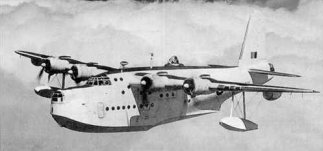
Short Sunderland
Derived from the pre-war Empire flying-boat, the Sunderland became a legend in World War II as the main patrol flying-boat of British Commonwealth forces. It was tough and reliable, performing just about any maritime task including U-boat hunting, air-sea rescue and transport. Adversaries found the Sunderland a prickly customer and nicknamed it 'The Flying Porcupine'.
When the Short Sunderland entered service in 1938, this big seaplane gave the RAF the endurance for gruelling 20 hour patrols. During the war Sunderlands undertook many dangerous missions, including evacuating Crete by making trips with up to 82 armed passengers plus a 10 man crew. As the war progressed, improved Sunderlands introduced search radar with huge antennas atop the rear fuselage; no other aircraft was more capable at stalking and attacking U-boats.
The Sunderland carried bombs and depth charges internally, then cranked them out on underwing pylons when preparing to attack. Its gunners could rake the deck of an enemy submarine, preventing its crew from manning their own weapons.
Some Sunderlands became stripped, high-speed transports for British Overseas Airways Corporation. During the 1948 Berlin Airlift Sunderlands lifted almost five million kilograms of freight flying hazardous mercy missions.
The final Sunderland introduced Pratt & Whitney R-1890-90B Twin Wasp engines to replace the reliable but somewhat underpowered Pegasus. This impressive aircraft remained the standard RAF ocean flying-boat until its retirement in 1959.
 |
 |
 |
| Short Brothers' expertise in flying-boat design was perfected with 'Empire'-type boats before the war. The Sunderland first flew in October 1937 and the type was operational by 1938. |
Sunderlands operated from some of the most remote areas in Europe and Asia. The crew had comfort of knowing that they could always land on the sea if the engines failed. |
On land, the Sunderland looked clumsy and heavy But its performance in the air surprised many enemy pilots, who learned to treat this aircraft with respect. |
|
Short Sunderland (Technical Specification) |
| Role |
Long-range reconnaissance and anti-submarine flying-boat |
| Manufacturer |
Short |
| Maximum Speed |
341 kmh (211 mph) |
| Maximum Range |
4828 km (2,993 miles) |
| Ceiling |
5,300 meters (17,930 feet) |
Weight
Empty
Maximum Takeoff |
15,663 kg (34,459 lbs)
26,308 kg (57,878 lbs) |
Dimensions
Wingspan
Length
Height
Wing Area |
34.38 meters (113 ft)
26.01 meters (85 ft)
9.79 meters (32 ft)
138.14 square meters (1,486 sq ft) |
| Engines |
Four Bristol Pengasus XVIII nine-cylinder radial piston engines each providing 794-kW (1,064-hp) |
| Armament |
Eight 7.7 mm (0.303 cal) Browning machine-guns in nose, dorsal and quad tail turrets
Some fitted with four fixed forward-firing 7.7 mm and twin 12.7 mm (0.50 cal) Brownings in waist
2250 kg (4,950 lbs) of bombs, depth charges, mines or pyrotechnics |
Photo Gallery
Click here to submit your photo
| Have A Passion For Aircraft? |
Subscribe to our 14 series FREE newsletter
delivered weekly on World War 2 Aircraft factfile... |
| NB:- We hate spam as much as you do, so your email address will NEVER be shared with or sold to anyone else. That's a Guarantee. |
|
|





